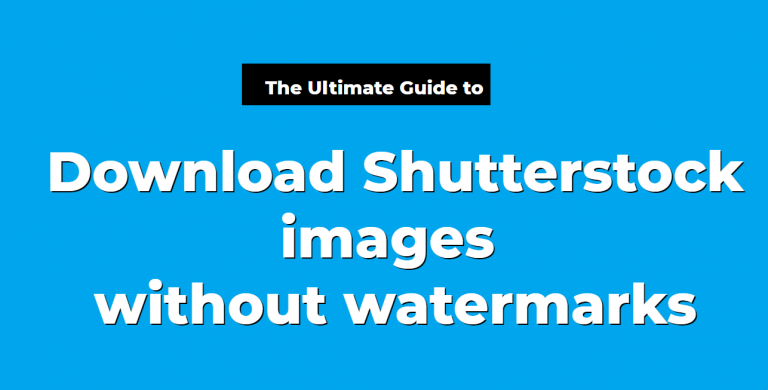If you’ve ever come across a stunning Shutterstock image and wanted to use it for your project, you probably noticed the watermark that covers the image. Watermarks are like digital signatures that protect photographers’ rights and prevent unauthorized use. But sometimes, you might want to obtain a clean, watermark-free version of the image, whether for personal use, a presentation, or a commercial project. In this post, we’ll explore how you can legally and ethically access Shutterstock images without watermarks, what those watermarks are all about, and why they exist. Let’s dive in!
Understanding Why Shutterstock Images Are Watermarked

So, you might be wondering, why does Shutterstock put watermarks on their images in the first place? Well, it all comes down to protecting the rights of photographers and ensuring fair compensation. When you browse Shutterstock’s library, you’re actually seeing a preview version of the images, which includes a watermark—a semi-transparent overlay with the Shutterstock logo or other identifying marks. This watermark acts as a deterrent against unauthorized use and copying.
Here’s what watermarks do:
- Prevent unauthorized downloads: Without paying or licensing, it’s tough to get a clean image, which discourages theft.
- Encourage licensing: The watermarked preview nudges users to purchase the image if they want to use a high-quality, watermark-free version.
- Protect photographers’ rights: Watermarks make it clear who owns the image and help ensure creators get paid for their work.
It’s important to understand that these watermarks are not just a marketing tool—they serve as a legal safeguard for the rights holders. Downloading or using an image without paying for it, especially if the watermark is removed without permission, can lead to legal issues. So, while it might seem tempting to find ways around the watermark, the best approach is to go through the proper channels—either by purchasing the image or using free, legal alternatives. Next, we’ll explore how you can access watermark-free images legally and ethically.
Legal Ways to Obtain Shutterstock Images Without Watermarks
If you’re looking to get high-quality Shutterstock images without those pesky watermarks, the best route is to do it legally. It might seem tempting to try and find workarounds, but that can lead to serious legal troubles, including copyright infringement. So, let’s explore the legitimate methods you can use to access watermark-free images.
1. Purchase a License
The most straightforward way to get images without watermarks is by purchasing the appropriate license directly through Shutterstock. When you buy a license, you’re granted legal permission to use the image in your projects, and the watermark is removed automatically. Shutterstock offers various licensing options, including:
- Standard License: Suitable for most digital and print uses like websites, social media, and marketing materials.
- Enhanced License: For higher usage needs, such as merchandise or large-scale prints.
2. Subscribe or Purchase Credits
Shutterstock offers subscriptions and credit packs that make downloading images more affordable. With a subscription, you pay a fixed monthly fee and get a set number of downloads—each image coming without watermarks once downloaded legally. Credits work similarly but are used on a per-download basis, depending on the image size and licensing type.
3. Use Free Resources Offered by Shutterstock
Sometimes, Shutterstock provides free images or free trials which include watermarked images you can preview. While you can’t use these for your final project without licensing, they’re perfect for brainstorming or mockups. Always upgrade to a licensed version to use the image legally.
4. Contact Shutterstock for Custom Licensing
If you have unique needs—like a large-scale campaign or exclusive rights—reach out to Shutterstock’s licensing team. They can offer custom licensing agreements that suit your project, ensuring you stay on the right side of copyright law.
Using the Shutterstock Website to Preview and Download Images Legally
Another great way to access images legally is by navigating Shutterstock’s website. They make it simple to preview and then download images once you’ve secured a license. Here’s how to do it right:
1. Create an Account
First, sign up for a Shutterstock account. It’s free to create an account, and doing so allows you to save images to collections, preview images in high resolution, and eventually download them once licensed.
2. Search and Preview
Use the search bar to find images relevant to your project. Shutterstock provides high-quality previews with watermarks, so you can see exactly how an image will look before committing. Hover over images to see details like resolution, file type, and licensing options.
3. Add Images to Your Cart or Collection
When you find images you like, add them to your shopping cart or your personal collections. This helps you organize your options and compare different images before making a purchase.
4. Purchase and Download Legally
Once you’re ready, select the image and proceed to checkout. You’ll choose your license type and payment method. After completing the purchase, the image will be available for download in high resolution, free of watermarks, and fully licensed for your use.
| Step | Action |
|---|---|
| 1 | Create an account on Shutterstock |
| 2 | Search for images and preview with watermarks |
| 3 | Add images to your cart or favorites |
| 4 | Purchase the license and download the high-quality image |
Remember, always respect licensing agreements and copyright laws. Using images without proper licensing can lead to legal issues, so it’s best to follow the proper channels provided by Shutterstock to get your images legally and ethically.
Purchasing Licenses for High-Quality Watermark-Free Images
If you’re serious about using Shutterstock images for your projects, the most straightforward and legitimate way to get high-quality, watermark-free images is by purchasing a license. Shutterstock offers various licensing options designed to fit different needs, whether you’re a small business owner, a blogger, or a large corporation.
Why buy a license? When you purchase a license, you’re legally allowed to use the image without watermarks, in high resolution, and for your intended purpose — whether that’s for print, digital, or commercial use. Plus, you get peace of mind knowing you’re complying with copyright laws and avoiding potential legal issues down the line.
Here’s a quick rundown of the typical licensing options:
- Standard License: Suitable for most personal and commercial uses, like websites, social media, brochures, and presentations. It generally allows for up to 500,000 copies or views.
- Enhanced License: Needed if you plan to use the image in products for resale, such as merchandise or large-scale print runs. It offers broader rights and higher usage limits.
Purchasing a license is simple:
- Log into your Shutterstock account or create one.
- Search for the image you want.
- Click on the image to view details.
- Select the appropriate license type based on your needs.
- Choose the download size (standard or high resolution).
- Add the image to your cart and proceed to checkout.
Once purchased, you can download the image in its full quality, free of watermarks, and use it as permitted by the license. This is the most reliable way to get high-quality images legally and ethically, supporting the hardworking photographers and designers behind each shot.
Alternative Methods and Tools for Accessing Shutterstock Images Legally
If purchasing a license for each image feels a bit daunting or expensive, don’t worry — there are other legitimate ways to access Shutterstock images without watermarks, especially if you need images regularly or in bulk.
Here are some options:
Subscription Plans
Shutterstock offers various subscription plans that give you a set number of downloads per month or year. These plans often come with discounted rates per image and allow you to access high-quality, watermark-free images once you download them. This is perfect for users who need multiple images regularly.
On-Demand Image Packs
If you have sporadic needs, on-demand packs let you buy a set number of images upfront at a lower cost. Once purchased, you can download the images watermark-free anytime within your license period.
Free and Creative Commons Alternatives
While not Shutterstock images, several reputable sites offer free, high-quality images with flexible licenses, including:
- Unsplash: Free high-resolution photos contributed by photographers worldwide.
- Pexels: Free images and videos licensed for personal and commercial use.
- Pixabay: A vast library of free stock photos, vectors, and illustrations.
Always check the license terms before use to ensure compliance. These sites are great if you’re looking for budget-friendly options or quick access without watermarks.
Using Shutterstock’s API for Business Integrations
If you’re a business or developer, Shutterstock offers an API that allows you to integrate image access directly into your apps or websites. This way, you can search, preview, and purchase images seamlessly, often with license management built-in. It’s a more advanced route but offers convenience and control for large-scale projects.
Legal Considerations
Remember, trying to bypass watermarks through unauthorized tools, hacks, or downloading from unofficial sources is risky and illegal. Always stick to licensed downloads or authorized free sources to support creators and stay on the right side of copyright law.
In summary, whether through purchasing licenses, subscribing, or exploring free alternatives, there are plenty of legal avenues to access high-quality Shutterstock images without watermarks. It might cost a bit upfront, but it’s the safest, most ethical way to ensure your project’s success and legality.
Tips for Respecting Copyright and Avoiding Unauthorized Downloads
Using images from Shutterstock is a fantastic way to enhance your projects, but it’s super important to do so responsibly. Respecting copyright not only keeps you out of legal trouble but also supports the hardworking photographers and artists behind those stunning visuals. Here are some practical tips to help you stay on the right side of copyright laws and avoid accidentally downloading images without proper permissions.
First and foremost, always purchase or license images legally. Shutterstock’s platform is designed to ensure that when you pay for an image, you’re getting the rights to use it as specified. Avoid searching for “free” versions of Shutterstock images on unofficial sites; these are often illegal copies and can lead to serious legal issues.
Next, familiarize yourself with Shutterstock’s licensing agreements. They clearly outline what you can and cannot do with the images. For instance, standard licenses typically cover most uses like websites, presentations, and social media, but if you need to print large banners or merchandise, you might require an extended license. Reading these details helps you avoid misuse.
Be cautious with third-party tools or unofficial downloaders claiming to provide Shutterstock images without watermarks. These are often illegal and can contain malware or viruses. Stick to Shutterstock’s official platform or authorized partners.
Here are some simple habits to adopt:
- Always log into your Shutterstock account before downloading to ensure you’re authorized.
- Double-check the license type for each image to ensure it fits your project’s needs.
- Keep records of your licenses and receipts in case you need proof of purchase or license validity later.
- Avoid sharing downloaded images with others unless they also have proper licenses; sharing unlicensed images can lead to copyright infringement.
- Report suspicious sites or unauthorized sources that claim to offer Shutterstock images without watermarks. This helps protect the community and ensures creators are compensated.
Remember, respecting copyright isn’t just about legality—it also shows appreciation for the creators who put time and effort into making beautiful images. When you follow these tips, you’re not just avoiding trouble; you’re also supporting a fair and sustainable creative ecosystem.
Conclusion and Best Practices for Using Shutterstock Images Legally
Using Shutterstock images can significantly elevate your content, but it’s crucial to do so responsibly and legally. The best way to enjoy these high-quality visuals while respecting copyright is to follow some straightforward best practices.
First, always purchase and license images through official channels. This guarantees that you have the right to use the images as intended and supports the artists behind them. Remember to select the appropriate license type—standard or extended—based on your project requirements.
Second, keep thorough records of your licenses and receipts. This documentation can be invaluable if there’s ever a question about your rights to use an image.
Third, understand the scope of your license. For example, some licenses might restrict the number of copies, geographic distribution, or type of use. Being aware of these limits helps you avoid accidental infringement.
Fourth, give proper attribution when required. While Shutterstock images typically don’t require attribution unless specified, always check the licensing terms. Proper attribution not only respects creator rights but also enhances your credibility.
Fifth, avoid downloading images from unofficial or shady sources claiming to offer free or watermarked Shutterstock images. These are often illegal and could compromise your device’s security.
Finally, stay updated on copyright laws and Shutterstock’s licensing policies. Laws can change, and platforms may update their terms, so a little ongoing education goes a long way.
In summary, the key to using Shutterstock images legally is to license them properly, understand your rights and restrictions, and respect the work of creators. By following these best practices, you can confidently incorporate stunning visuals into your projects, knowing you’re doing so ethically and legally. Happy creating!


